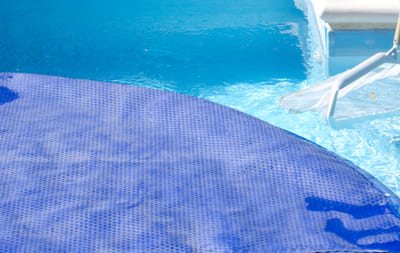Do Solar Pool Covers Really Work
Article posted by Gregory Grochola (physicist) on 16th Feb 2019
So we get asked do solar pool covers really work, do they really heat the pool? To answer that question authoritatively with some actual scientific proof let's look at the numbers.
We can analyse the pool temperature increase from a transparent pool cover using our new simulator (checked against the pool heat loading standards AS 3634-1989 and ISO TR 12596 1995 here). So what we did was work out, under different scenarios what kind of temperature increase you're going to get in the colder shoulder pool heating months for all Australian capitals. Pool cover companies tend to say you'll get "up to" 7-8oC from a CSIRO and Rheem study - which is technically true in the most optimistic case, 100% usage, using the best state (Canberra) and during summer, but more realistically, it's a little more complex...
Pool Cover Water Temperature Increase
A word of caution here: all the below calculations are for blue, bubble style transparent blankets. Darker blankets will not be as good in terms of energy conservation as they block the sun and cool the pool (Czarnecki, CSIRO TR19, 1978).
The table shows various temperature increases from a solar pool blanket, covered 100% of the time in the heating months. Now by heating months we mean, mainly summer in colder areas like Hobart, Melbourne, ect... mainly spring and autumn in Perth, Sydney, Brisbane, and the winter months in Darwin. Now you should take note, these numbers are averages, over days and nights, over warm days and cold days so the boost in a warm spell during the day will be more, up to 130% more. Do also consider that these numbers are for 100% ON, whereas it's not possible to have a cover on 100% of the time if you're actually going to be using a pool... so scale these numbers by fractional pool cover usage if you have to...
Windy/Exposed
Light Walls
No Solar
Windy/Exposed
Light Walls
No Solar
Wind/Sheltered
Light Walls
No Solar
Wind/Sheltered
Dark Walls
No Solar
Wind/Sheltered
Dark Walls
Solar Heating
KEY: "Shade" means shading on a pool. "Windy/Exposed" or "Sheltered" means the pool is either fully exposed to a windy area or fully sheltered and situated in a wind-sheltered area respectively (two extremes). "Light/DarkWalls" refers to the colour of the pool surfaces i.e. floor and walls. Lastly, solar means we're running a solar pool heater system (with 67% OKU panel coverage).

Here's what we find: the more sun and energy going into the pool the more effective a pool cover is going to be in boosting temperatures. This makes perfect sense; a solar pool cover doesn't introduce heat, it only insulates your pool. So if you don't have much heating input and if for example you've got some shading on your pool which reduces the amount of sun energy going into your pool - then a solar cover won't do that much for you in terms of increasing pool temperatures. And if you have 100% shaded pool forget it, it won't do much at all.
That's not to say pool covers are no good for other reasons, for example they are great for reducing chemical usage and keeping leave out and reducing evaporation ect... but in terms of heating a pool you really need the heat input to see the greatest temperature boosts. So for example, with a solar pool heating system in place, you then add a blanket you're going to get a whopping 9-10oC temperature increase - IN ADDITION to what you get from solar. Also of course if you've got a solar heating system and you don't have a blanket cover you're really missing out on 9-10oC temperature extra temperature gains.
Try to our pool heating cost simulator and have a play with it :)
If you've recently installed a pool cover, and let us know your experiences, specifically how you've made it easy to get on or off, as people to tend to site that as a distinct disadvantage with pool covers.
We think they are great and everyone should invest in one (expect perhaps people that have a shaded pool, you guys really ALSO need a solar pool heater.
If you enjoy this article please share, it'll help us get the word out about solar and renewables.

